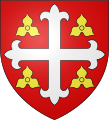
The fleur-de-lis, also spelled fleur-de-lys, is a common heraldic charge in the (stylized) shape of a lily. Most notably, the fleur-de-lis (⚜️) is depicted on the traditional coat of arms of France that was used from the High Middle Ages until the French Revolution in 1792, and then again in brief periods in the 19th century. This design still represents France and the House of Bourbon in the form of marshalling in the arms of Spain, Quebec, and Canada — for example.

A shamrock is a type of clover, used as a symbol of Ireland. Saint Patrick, one of Ireland's patron saints, is said to have used it as a metaphor for the Christian Holy Trinity. The name shamrock comes from Irish seamróg, which is the diminutive of the Irish word seamair and simply means "young clover".

Mehmedalija "Mak" Dizdar was a Bosnian poet. His poetry combined influences from the Bosnian Christian culture, Islamic mysticism and cultural remains of medieval Bosnia, and especially the stećci.

The vesica piscis is a type of lens, a mathematical shape formed by the intersection of two disks with the same radius, intersecting in such a way that the center of each disk lies on the perimeter of the other. In Latin, "vesica piscis" literally means "bladder of a fish", reflecting the shape's resemblance to the conjoined dual air bladders found in most fish. In Italian, the shape's name is mandorla ("almond"). A similar shape in three dimensions is the lemon.

The coat of arms of Poland is a white, crowned eagle with a golden beak and talons, on a red background.

Rose window is often used as a generic term applied to a circular window, but is especially used for those found in Gothic cathedrals and churches. The windows are divided into segments by stone mullions and tracery. The term rose window was not used before the 17th century and comes from the English flower name rose.
In heraldry, a charge is any emblem or device occupying the field of an escutcheon (shield). That may be a geometric design or a symbolic representation of a person, animal, plant, object, building, or other device. In French blazon, the ordinaries are called pièces, and other charges are called meubles.

Tracery is an architectural device by which windows are divided into sections of various proportions by stone bars or ribs of moulding. Most commonly, it refers to the stonework elements that support the glass in a window. The purpose of the device is practical as well as decorative, because the increasingly large windows of Gothic buildings needed maximum support against the wind. The term probably derives from the tracing floors on which the complex patterns of windows were laid out in late Gothic architecture. Tracery can be found on the exterior of buildings as well as the interior.

The universal recycling symbol is a symbol consisting of three chasing arrows folded in a Möbius strip. It is an internationally recognized symbol for recycling. The symbol originated on the first Earth Day in 1970, created by Gary Anderson, then a 23-year-old student for the Container Corporation of America. The symbol is not trademarked and is in the public domain. Many variations on the logo have been created since its creation.

The first coat of arms of Montreal was designed by Jacques Viger, the first mayor of Montreal, and adopted in 1833 by the city councillors. Modifications were made some one hundred five years later and adopted on 21 March 1938, and again on 13 September 2017, resulting in the version currently in use. The coat of arms was the only city emblem representing Montreal until 1981, when a stylized logo was developed for common daily use, reserving the coat of arms for ceremonial occasions.

A quatrefoil is a decorative element consisting of a symmetrical shape which forms the overall outline of four partially overlapping circles of the same diameter. It is found in art, architecture, heraldry and traditional Christian symbolism. The word 'quatrefoil' means "four leaves", from the Latin quattuor, "four", plus folium, "leaf"; the term refers specifically to a four-leafed clover, but applies in general to four-lobed shapes in various contexts. In recent years, several luxury brands have attempted to fraudulently assert creative rights related to the symbol, which naturally predates any of those brands' creative development. A similar shape with three rings is called a trefoil, while a shape with five is a cinquefoil.

The Association of Scouts of Azerbaijan the national Scouting organization of Azerbaijan, was founded in 1997, and became the 150th member of the World Organization of the Scout Movement on 20 August 2000. In 2017 it was admitted as a full member in the World Association of Girl Guides and Girl Scouts. The coeducational association has 1,571 members as of 2021, about 35% are girls.
The Danish Scout Council is the national Scouting federation of Denmark. Scouting was founded in Denmark in 1909 and it was among the charter members of WOSM in 1920. Denmark has 70,000 Scouts.

Howden Minster is a large Grade I listed Church of England church in the Diocese of York. It is located in Howden, East Riding of Yorkshire, England and is one of the largest churches in the East Riding. It is dedicated to St Peter and St Paul and it is therefore properly known as 'the Minster Church of St Peter and St Paul'. Its Grade I listed status also includes the Chapter House.

Christian symbolism is the use of symbols, including archetypes, acts, artwork or events, by Christianity. It invests objects or actions with an inner meaning expressing Christian ideas.

Episcopal Church of the Nativity is a church in Huntsville, Alabama. It was built in the Gothic Revival style in 1859. It is noted as one of the most pristine examples of Ecclesiological Gothic architecture in the South. It is also one of the least-altered structures by architect Frank Wills and one of only thirteen surviving houses of worship designed by him in the United States. It was declared a National Historic Landmark in 1990.
A trefoil is a graphic form composed of three leaves or lobes.
Blaško Stipan Rajić was a Catholic priest, writer and politician from the region of Bačka who was known for his involvement in the creation of Yugoslavia after the Croatian national revival. He wrote poetry and prose works.

Church architecture of England refers to the architecture of buildings of Christian churches in England. It has evolved over the two thousand years of the Christian religion, partly by innovation and partly by imitating other architectural styles as well as responding to changing beliefs, practices and local traditions. Christian architecture encompasses a wide range of both secular and religious styles from the foundation of Christianity to the present day, influencing the design and construction of buildings and structures in Christian culture. From the birth of Christianity to the present, the most significant period of transformation for Christian architecture and design was the Gothic cathedral.






























